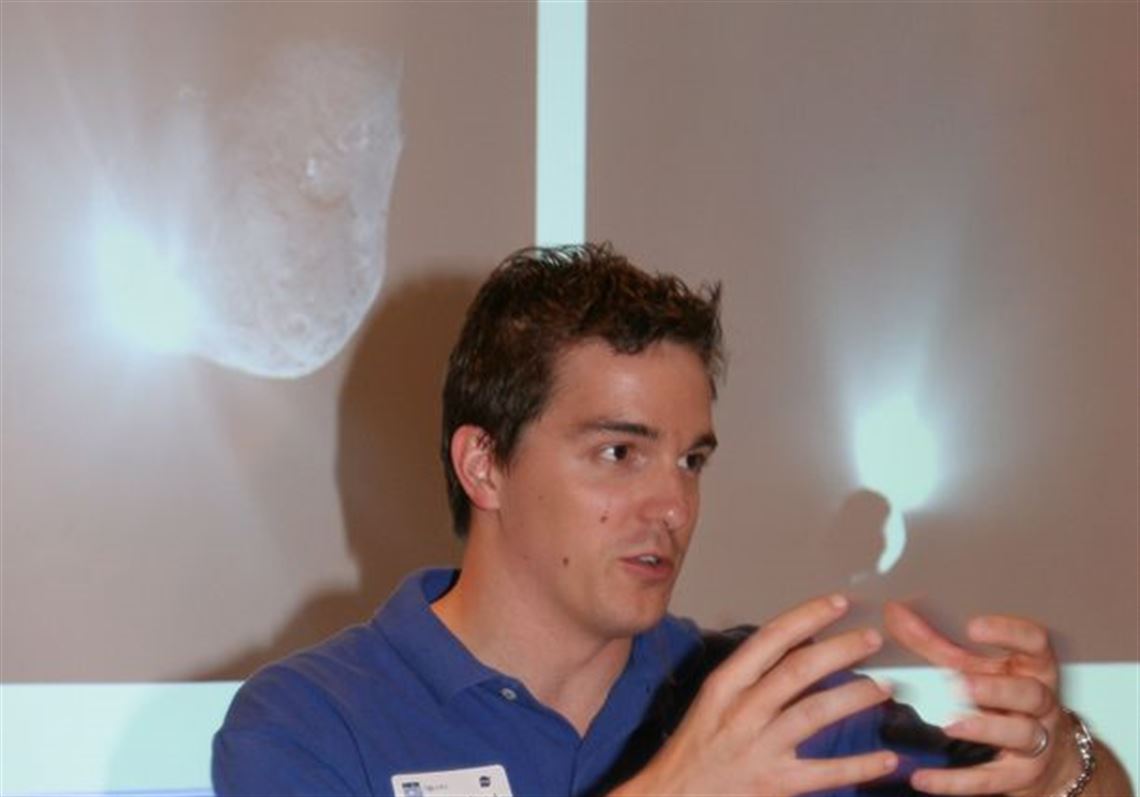Many of the photos that a young California couple flew to Ohio to show at COSI yesterday - and which cost federal taxpayers hundreds of millions of dollars to shoot - turned out to be a few white dots on a black background.
But paired with Steve and Jaime Waydo's stories of their work at NASA's Jet Propulsion Laboratory, the pictures - some of them unpublished - of comets, Mars, and a view of Earth from Mars appeared to fascinate their audiences at the downtown Toledo science museum.
"It was really interesting we got to see pictures the news hasn't seen yet," said 15-year-old Kaylyn Matthews, a Clay High School sophomore who said the Waydos were the first NASA engineers she'd met.
Mr. Waydo told about lots of down-to-earth work - one of his pictures showed the cot in his office where he took short naps in the midst of working 14 to 15-hour days, seven days of week - to learn more about what happens out of this world with the Deep Impact mission.
"This was a very risky mission, and there was significant worry that it wouldn't work," said Mr. Waydo, 26.
Best case scenario, which appears to be what happened last month, was this:
An unmanned spacecraft the size of a small sport utility vehicle that was launched in January would release an 820-pound, beach ball-sized impactor on Independence Day. The impactor would knock a football stadium-sized hole in a comet that's about the size of downtown Toledo. Scientists could then determine - from lots of pictures transmitted back to Earth - more about what comets are made of.
Worst case scenario was that the spacecraft would blow up, go in the wrong direction, or otherwise be uncontrollable, and waste the $330 million that taxpayers spent on it.
Mrs. Waydo, 28, told about her work with the Mars Orbiter, launched Friday, and the Mars Rover launched earlier.
When she asked her audience of about 60 people if they would like to go to Mars someday, her husband was among those who shot up his hand - even though he already knew what she was about to say next.
Temperatures there are 81 degrees below zero, which is one of many reasons why NASA plans to use robots rather than people for its early explorations.
Almost invariably - and the crowd at COSI was no exception yesterday - the Waydos are peppered with questions such as:
One of the questions Mr. Waydo hoped most to hear was asked yesterday by 14-year-old Wesley Hughes, a freshman at Toledo Technology Academy, who inquired about the education necessary for such work at NASA.
Mr. Waydo's advice to youth is to pursue whatever interests them most. He knows electrical engineers at NASA who were once biologists. One of his friends there got a double major in astrophysics and theater.
Mr. Waydo, who grew up in the Columbus suburb of Upper Arlington, started college as a forestry major because he liked the outdoors, but switched to aeronautics and astronautics as a sophomore because the coursework seemed exciting.
Now he's working on a doctoral dissertation in neuroscience, studying how the brain allows people to remember what they do. The work, he said, includes remarkable similarities to designing spacecraft that can be aimed at a specific target.
"Obviously, the boxes that you're dealing with are different," he said. "But the mathematics are often the same."
That interested Mary Ann Gorney, of Point Place, who took two grandchildren to hear the Waydos.
Why, she initially wondered, can NASA build a spacecraft that operates for years on solar power and we're still putting gasoline in cars?
"You'd think they could do a lot more here on Earth if they can do this," she said.
But after hearing about Mr. Waydo's latest endeavors, she agreed that much of science is connected.
COSI paid for the Waydos' flight and hotel room, but the couple spent the day at the museum without a speaker's fee.
"It's a lot of fun and it's important to talk to the kids," said Mr. Waydo, who rose at 4 a.m. - which was 1 a.m. California time - yesterday to promote their appearance with interviews on Toledo television shows.
Contact Jane Schmucker at: jschmucker@theblade.com or 419-337-7780.
First Published August 14, 2005, 10:51 a.m.


